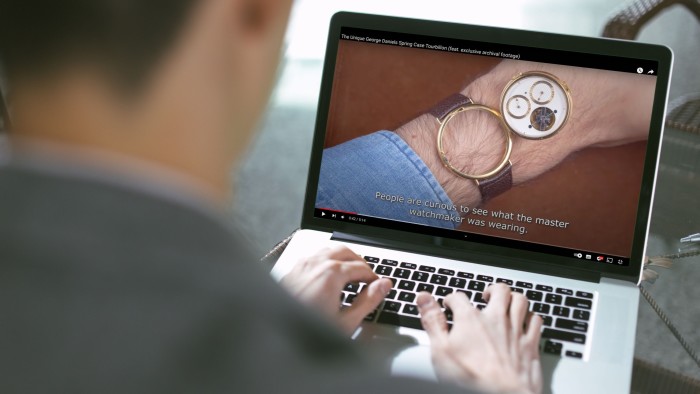Rising consumer demand brings investment in luxury visual media

Roula Khalaf, Editor of the FT, selects her favourite stories in this weekly newsletter.
When it came to telling the story behind the ‘Naissance d’une Montre 2’ [Birth of a Watch] project, Phillips decided to film the independent watchmakers who collaborated on the unique piece ahead of its sale in May.
And this type of content is now a growing focus for the business, which is opening a new 37 sq m video studio for its watch department in Geneva. “We believe that some watches deserve their stories to be told for a larger audience, not just the people who are interested in buying,” says Arthur Touchot, international head of digital strategy at Phillips.
With the pandemic accelerating online sales, and social media fuelling demand for content, other sellers of watch and jewellery are also investing in visual assets.
Boodles spends upwards of £500,000 on photography and video annually, which James Amos, marketing director at the British jeweller, says is about triple the amount pre-pandemic. A significant share goes on imagery for its website and ecommerce, for which the brand previously employed an in-house photographer before switching to a specialist company to create still images of pieces from different angles and videos of models wearing the jewellery.
Amos says it is not easy to track return on investment. “Of course, one would assume that with better images of your jewellery, you’re more likely to attract customers from your website into your shops, or you’re definitely more likely to sell through ecommerce because they can see what they’re getting,” he says.
According to Amos, Boodles’ ecommerce transactions in the financial year to the end of February were 97 per cent higher than they were in the same period three years earlier. Ecommerce revenue grew by 506 per cent over that time. Similarly, Amos notes that the “glass ceiling” for an online sale has risen from £4,000 pre-pandemic to £10,000 now. Boodles achieved its highest “click-and-buy sale” to date, at £40,000, last month.
Amos believes better imagery creates confidence. “If the image looks good, and [is] not just an image of a piece of jewellery on its own but, ideally, moving on a person, then the [customer] is in a better place to make the decision without having to travel,” he says.
Videos can provide potential buyers with a more detailed understanding of an item, too — which can help build trust and prompt more competitive bidding, says Touchot. He says the collector who paid SFr4.08mn ($4.09mn) for the George Daniels Spring Case Tourbillon in November mentioned that watching a Phillips video, which included previously unaired footage of Daniels wearing the watch, motivated him to place the winning bid.
At the other end of a sale, there are more requests for video content from clients consigning watches, who “see it as a powerful marketing tool”.
Phillips, which already has a photography studio, plans to use its new video studio to create “snackable content” of 30-60 seconds for the Phillips Watches Instagram account’s 178,000 followers, as well as five to 10-minute videos featuring collector interviews, expert reviews and provenance stories, and an annual longer feature.
Thirty-four per cent of Phillips’ private buyers last year were millennials, up from 31 per cent in 2021. “The vast majority in that group has grown up looking at watches on screens, on social media and on YouTube,” says Touchot. “Still imagery and printed material, while still important, are not enough to engage this audience.”
Graff has expanded its in-house team due to the growing importance of image creation to the business. The jeweller first opened a photography studio in its Mayfair headquarters in 2012 with one photographer, who doubled as a graphic designer. Now, it has a full-service creative studio comprising a permanent photography studio team of three and a four-strong creative design team. It has four to 10 specialist consultants and freelancers — based globally to ensure 24-hour support — working at any one time retouching and editing imagery.
Graff shoots an average of 100-plus pieces in its studio every month and collaborates with external photographers on advertising campaigns. Last year, it moved from having an average of six main visuals in its annual brand campaign to more than 40 launched throughout the year across different channels.
But brands are not only investing in their own content. Influencers and journalists at the Watches and Wonders fair, opening on March 27 in Geneva, can shoot Montblanc’s watches in a photography studio with props inspired by Mont Blanc mountain and materials including acrylic ice, bio-organic snow, marble and granite. “We realised that, despite the fact that we come up with some images that are done in-house to really inspire our audience, it’s also good to create a space for the content creators to be able to manage very authentic pictures better fitting their [own channels],” explains Vincent Montalescot, Montblanc’s chief marketing officer.
Meanwhile, Hanover Saffron Creative, a photography studio in London’s Hatton Garden jewellery district, is producing more single product shots for brands, as well as animations, short videos and 360-degree views of jewellery, says owner Colin Shakespeare.
Although the advance of mobile, camera and digital technology meant some brands had taken their photography in-house, he says things have come full-circle. “A lot of people are realising that they need to stick out from the crowd — and they need quality,” he says.
Comments